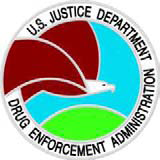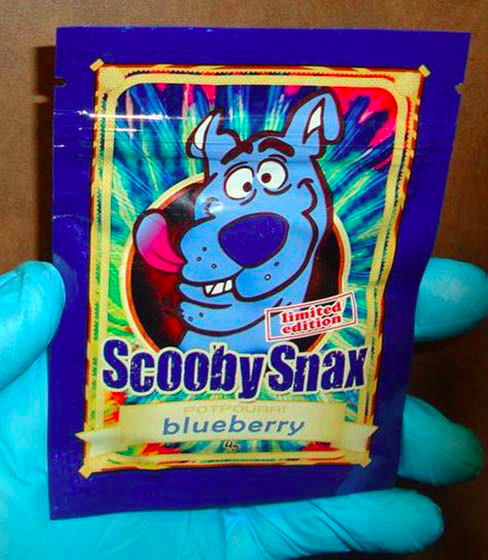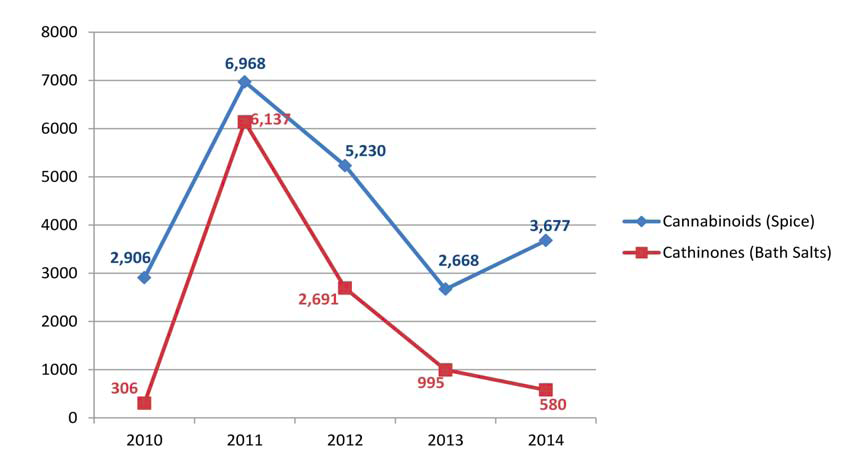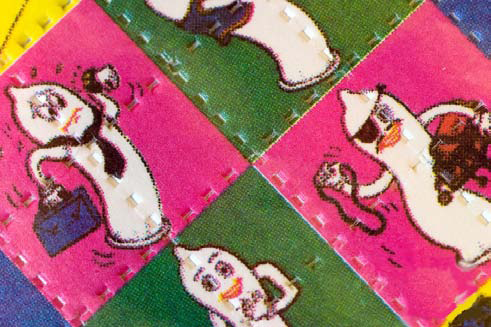Part 86 United States Drug Enforcement Administration Releases 2015 National Drug Threat Assessment Summary Synthetic Designer Drugs. Cannabinoids, cathinones, and hallucinogens known as phenethylamines. Spice, K2, bath salts. China. Heart attack, kidney and liver failure, paranoia, panic attacks, and breakdown of muscle tissue. Blueberry, strawberry, mango, and bubblegum. Stigma. Smuggling Mexico DEA ICE FDA
[2015 Drug Threat Assessment Continued from Part 85 Marijuana]

2015 National Drug Threat Assessment Synthetic Designer Drugs
The US Drug Enforcement Administration 2015 National Drug Threat Assessment (NDTA) is a comprehensive report of the threat posed to the United States by the trafficking and abuse of illicit drugs, the nonmedical use of CPDs, [Controlled Prescription Drugs] , money laundering, TCOs [Transnational Criminal Organization] , gangs , smuggling, seizures, investigations, arrests, drug purity or potency, and drug prices, in order to provide the most accurate data possible to policymakers, law enforcement authorities, and intelligence officials.
Overview Synthetic Designer Drugs
Part 86 United States Drug Enforcement Administration Releases 2015 National Drug Threat Assessment Summary Synthetic Designer Drugs. Cannabinoids, cathinones, and hallucinogens known as phenethylamines. Spice, K2, bath salts. China. heart attack, kidney and liver failure, paranoia, panic attacks, and breakdown of muscle tissue. Blueberry, strawberry, mango, and bubblegum. Stigma.
Synthetic designer drugs refer to man-made substances created to mimic the effects of controlled substances, and are oftentimes unscheduled and unregulated. There are a variety of synthetic designer drugs, such as cannabinoids, cathinones, and hallucinogens known as phenethylamines. The two most commonly used types of synthetic designer drugs in the United States are synthetic cannabinoids and cathinones.
Synthetic cannabinoids, also commonly known as “Spice” and “K2,” are chemicals synthesized in laboratories and simulate the biological effects of THC, the main psychoactive ingredient in marijuana. Cathinones, also commonly known as “bath salts,” can produce pharmacological effects substantially similar to cathinone, methcathinone, MDMA, amphetamine, methamphetamine, and cocaine. Synthetic cannabinoids and cathinones are typically manufactured in China and then imported into the United States through mail services; they are sold in convenience stores and via the Internet. Synthetic cathinones are usually snorted or swallowed in their powder or crystal forms. Negative effects of synthetic cathinone use include heart attack, kidney and liver failure, paranoia, panic attacks, and breakdown of muscle tissue.
Phenethylamines are organic compounds that affect the central nervous system, primarily by interacting with neurotransmitters. The NBOMes (N-methoxybenzyl) are a series of potent psychedelic drugs that fall under the phenethylamine class of synthetic drugs. Common drugs used in this series are 25I-NBOMe, 25B-NBOMe, and 25C-NBOMe, all three of which were temporarily placed into Schedule I of the CSA by DEA in November 2013, after they were linked to multiple deaths.
Availability Synthetic Designer Drugs
Synthetic cannabinoids, cathinones, and phenethylamines are available throughout the United States. Most domestic DEA offices report that synthetic cannabinoids and cathinones are moderately available, and that availability is mostly stable compared to 2013. The Chicago and Philadelphia FDs indicated less availability in 2014 compared with 2013, and the New Jersey and Seattle FDs reported higher availability in 2014 (See Table 11).
(U) Table 11: DEA Field Division Reporting of Synthetic Cannabinoidand Cathinone Availability in the First Half of 2014 and Comparison to Previous Period
Availability During First Half 2014
Availability Compared to Second Half 2013
Field Division
Atlanta Field Division Low Stable
Caribbean Field Division Low Stable
Chicago Field Division Moderate Less
Dallas Field Division High Stable
Denver Field Division Moderate Stable
Detroit Field Division Moderate Stable
El Paso Field Division Moderate Stable
Houston Field Division Moderate Stable
Los Angeles Field Division Nothing to Report Stable
Miami Field Division Low Stable
New England Field Division Moderate Stable
New Jersey Field Division Moderate More
New Orleans Field Division Moderate Stable
New York Field Division Moderate Stable
Philadelphia Field Division Low Less
Phoenix Field Division Moderate Stable
San Diego Field Division Moderate Stable
San Francisco Field Division Low Stable
Seattle Field Division Moderate Stable
St. Louis Field Division Moderate More
Washington Field Division Moderate Stable
• Jefferson City, Missouri: In 2014, DEA seized hundreds of kilograms of synthetic cannabinoids from numerous package, smoke, and convenience stores. Several of these stores began selling them after noticing that the profits of a local liquor store doubled by selling the drugs.
[79]
• Frederick, Maryland: In 2014, DEA arrested three individuals and seized hundreds of packets of synthetic cannabinoids from a group of gas stations. The drugs were produced locally in a warehouse and one gas station location sold as many as 50 to 60 packets of the drugs per day.
• Elyria, Ohio: In June 2014, DEA seized 1,500 packets of synthetic cannabinoids when they intercepted a parcel delivery service package that had originated in Oklahoma.
• Washington DC: Current reporting indicates that many gas station and convenience store owners state that, even if their stock of synthetic cannabinoids is seized, they will continue to restock and sell the drugs if they are not prosecuted, because the profits are so large.
(U) Photo 20. Spice is sold in legitimate packaging materials and food-associated varieties such as “Blueberry” to entice consumption. Source: DEA

Use Synthetic Designer Drugs.
Synthetic designer drugs are typically used by younger individuals. Synthetic cannabinoids and cathinones are sold in packages adorned with bright colors and cartoons to attract younger users. (See Photo 20.) These drugs are often marketed under varieties such as blueberry, strawberry, mango, and bubblegum, to entice consumption. The use of legitimate-looking packaging, coupled with availability in conventional stores, greatly reduces the stigma of these drugs.
Synthetic Cannabinoids Designer Drugs
Synthetic cannabinoid use remains prevalent throughout the United States. Synthetic cannabinoids are the fourth most popular drug used among 8th graders (after marijuana, inhalants, and amphetamines), the third most popular drug used among 10th graders (after marijuana and amphetamines) and the fourth most popular drug used among 12th graders (after marijuana, amphetamines, and Adderall®). In the most current MTF survey data, the percentage of 8th, 10th, and 12th graders surveyed who used synthetic cannabinoids declined from 6.4 percent in 2013 to 4.8 percent in 2014. The MTF survey also found that when posed the question, “How much do you think people risk harming themselves (physically or in other ways), if they try synthetic marijuana once or twice,” 27.1 percent answered with “great risk,” the selection with the highest level of risk.
• The American Association of Poison Control Centers (AAPCC) also indicates that in 2014, there were 3,677 calls to poison centers regarding synthetic marijuana exposure. This number is up from 2,668 in 2013—a 37.8 percent increase. (See Chart 35.) This is the first increase since the number of calls peaked in 2011 at 6,968; 2012 and 2013 showed a decline in the number of calls.
• In August 2014, the New Hampshire Governor declared a State of Emergency when, within a few days, over 40 people overdosed on bubblegum-flavored synthetic cannabinoids sold over the counter.
Synthetic Cathinones Designer Drugs
Some use and availability data indicators show that synthetic cathinone use is decreasing, yet cathinones remain prevalent in the US market.
[80]
• AAPCC statistics continue to show a declining number of calls to poison centers for cathinone exposure. For the year 2014, there were only 580 calls, a 41.7 percent drop from the 995 calls in 2013. In the previous reporting period from 2012 to 2013, the number of calls dropped from 2,691 to 995, a 63 percent decrease.
• NSS data reflect a significant decrease in the amount of cathinones seized since 2012. In 2012, law enforcement officers seized 990 kilograms of cathinones; however, in 2013, officers seized 839 kilograms and only 52.8 kilograms in 2014.
• MTF survey data show that the percentage of 8th, 10th, and 12th graders using cathinones
(U) Chart 35. Number of Exposure Calls to the American Association of Poison Control Centers 2010 – 2014 Source: American Association of Poison Control Centers

(U) Synthetic Cannabinoid Use among the Prison Population
Synthetic cannabinoids are used by the inmate population and others monitored by the criminal justice system. In a special study conducted under the Community Drug Early Warning System in 2013 by the Office of National Drug Control Policy (ONDCP) and the University of Maryland’s Center for Substance Abuse Research, an average of 33 percent of urine samples tested positive for synthetic cannabinoids in the Washington, DC inmate, parole and probation, and pretrial surveillance populations. These samples passed traditional drug screening and synthetic cannabinoids were only identified by special testing not ordinarily used in the criminal justice system.
• Clinton, Louisiana: In October 2014, four inmates in a Louisiana prison overdosed on synthetic cannabinoids smuggled into the prison concealed inside cigarettes. The inmates became unresponsive and were taken to the hospital. One was admitted to the Intensive Care Unit.
• Live Oak, Florida: In December 2014, a Florida prison correctional officer was arrested for selling synthetic cannabinoids to inmates. Inmates purchased the drugs from him using disposable prepaid cash cards. [81]
dropped from 0.9 percent in 2013 to 0.7 percent in 2014. MTF survey data also found that when asked the question, “How much do you think people risk harming themselves (physically or in other ways), if they try bath salts (synthetic stimulants) once or twice,” 48.5 percent answered with “great risk.”
While many indicators suggest declining abuse levels of synthetic cathinones, many distributors have “rebranded” these drugs as MDMA, “molly,” or “flakka” thereby users may not be aware they are consuming a synthetic cathinone or “bath salts.” Additionally, data could be skewed as unwitting users would indicate that they had consumed MDMA. The AAPCC register “bath salts” and MDMA as separate entities, which further distorts this data as an indicator of use levels.
Synthetic cathinones, namely methylone, are falsely represented as a pure form of ecstasy to MDMA users. Methylone has been seized in all forms of supposed MDMA: pressed pills, gel capsules, and loose powder crystals.
• New Jersey: In 2014, reporting indicated that much of the MDMA being trafficked in New Jersey was actually methylone. True MDMA was too expensive to make a profit so methylone was substituted.
• New York: In 2014, laboratory analysis showed most of the purported pure MDMA/“molly” contained cathinones such as methylone.
Phenethylamines
NBOMes are commonly imported into the United States from China in their white powder form. The drug can be diluted in liquid and snorted, dropped onto blotter paper and ingested orally, or administered as liquid drops directly into the eye or the nasal cavity. Once administered, effects of the drug may be felt in as little as 10 to15 minutes. Users experience temporary feelings of euphoria, visual and auditory hallucinations, as well as potential harmful effects such as aggression, agitation, seizures, kidney injury, and death. Due to similarities in appearance and effects, 25I-NBOMe is often mistaken for lysergic acid diethylamide (LSD). (See Photo 21.)
Photo 21. NBOMe blotter paper. Source: DEA

Production Synthetic Designer Drugs
While synthetic cannabinoids and cathinones are chemicals created in laboratories, each variety of these drugs requires different precursor chemicals and different scientific processes to synthesize them. While the varieties of synthetic cannabinoids and cathinones produce similar effects to the organic illicit drugs they mimic, they are each a different chemical; therefore, the synthesis of cannabinoids and cathinones vary as different methods are used to produce each compound variant. Most require relatively sophisticated scientific equipment and glassware, and the techniques require chemistry knowledge and skill. However, due to their wide availability from countries such as China, India, and the Netherlands, most traffickers in the United States simply purchase the chemicals already synthesized and perform final preparations and processing domestically. Sites for the final processing of synthetic cannabinoids and application onto plant material are known as “spice processing labs.” As synthetic cathinones are usually snorted or swallowed in their powder and crystal forms, further processing is usually not needed.
Spice processing labs are typically found in homes and warehouses throughout the United States. After acquiring synthetic cannabinoid chemicals, distributors dilute the white powdered substance in
UNCLASSIFIED
Synthetic Designer Drugs
an alcohol such as ethanol. Cheap plant material is dehydrated and spread out on large work surfaces. The synthetic cannabinoid chemicals in liquid form are then sprayed onto the plant material and left to dry. This can lead to the uneven application of the drug resulting in “hot spots” in batches of the drug. After drying, the finished “Spice” is packaged in individual foil packets, typically in 10 or 15 gram quantities.
The foil packets used for packaging synthetic cannabinoids can be purchased online in wholesale quantities. These packets are already branded with logos and names such as “Bizarro” or “Scooby Snax.” Because these empty packets can be purchased in wholesale quantities by different distributors, no two packets may have the same contents, as distributors use a variety of different synthetic cannabinoids in search of cheaper or more potent drugs. Therefore, any two sealed packets of “Scooby Snax” for sale may have two completely different synthetic cannabinoids, even in the same shop.
Transportation
The chemicals used to make synthetic cannabinoids and cathinones are typically purchased through mail order and transported into the United States via package delivery services. Synthetic cannabinoids and cathinones are usually imported into the United States from companies in China. To a lesser extent, synthetic cannabinoids and cathinones arrive in the mail from companies in Germany, the Netherlands, and even within the United States. These packages have been seized at both business and residential locations.
Distribution
Synthetic cannabinoids and cathinones are distributed through convenience stores, head shops, adult stores, hookah and smoke shops, and gas stations. While both vendors and the packaging of these drugs may claim that the drugs are not for human consumption, these drugs are usually sold along with smoking paraphernalia such as pipes. Some vendors display and sell these drugs openly, while some hide them from sight and sell only to customers with a trusted and established relationship. All 50 states have some type of legislation regulating the sale of synthetic drugs. However, the chemical make-up of synthetic drugs often differ by only one element, and this poses a challenge to law enforcement.39 As certain compounds are scheduled, producers quickly change one or two elements in the banned substance thereby creating a new compound that has similar psychoactive effects but is not yet illegal. Since 2009, when these drugs were first encountered in the US, more than 250 new synthetic compounds have been encountered.
Outlook
Synthetic cannabinoids, cathinones, and phenethylamines will continue to pose a nation-wide threat. Synthetic drug producers modify and experiment with chemical formulas in search of new psychoactive substances. Once a new drug is formulated, the Internet and social media are used to market its arrival on the scene, allowing
[83]
for its fast adoption and use. Due to the changing nature of the chemical formula for synthetic designer drugs, distributors are able to reap significant profits before legislation to control these psychoactive substances is enacted. While synthetic drugs will remain prevalent as a whole, synthetic cannabinoid use will remain steady or increase, while synthetic cathinone use appears to be on the decline. The United States will continue to see overdoses and deaths as a result of synthetic drug use, primarily among the youth population.
Disclaimer: The author of each article published on this web site owns his or her own words. The opinions, beliefs and viewpoints expressed by the various authors and forum participants on this site do not necessarily reflect the opinions, beliefs and viewpoints of Utah Standard News or official policies of the USN and may actually reflect positions that USN actively opposes. No claim in public domain or fair use. © Edmunds Tucker. UTopiAH are trade marks of the author. Utopia was written in 1515 by Sir Thomas More, Chancellor of England.
[2015 Drug Threat Assessment continues next at Part 87 MDMA Methyl dioxy methamphetamine]
Utah Standard News depends on the support of readers like you.
Good Journalism requires time, expertise, passion and money. We know you appreciate the coverage here. Please help us to continue as an alternative news website by becoming a subscriber or making a donation. To learn more about our subscription options or make a donation, click here.
To Advertise on UtahStandardNews.com, please contact us at: ed@utahstandardnews.com.


Comments - No Responses to “Part 86 United States Drug Enforcement Administration Releases 2015 National Drug Threat Assessment Summary Synthetic Designer Drugs. Cannabinoids, cathinones, and hallucinogens known as phenethylamines. Spice, K2, bath salts. China. Heart attack, kidney and liver failure, paranoia, panic attacks, and breakdown of muscle tissue. Blueberry, strawberry, mango, and bubblegum. Stigma. Smuggling Mexico DEA ICE FDA”
Sure is empty down here...